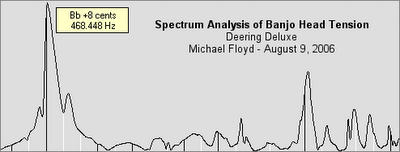Banjo Head Audio Spectrum Analysis

This post may not be of interest to most, but for those of you interested in the science behind trying to make your banjo sound its best, read on.
There is a technique for tuning banjo heads that involves striking the head with a hard object such as a metal finger pick or your fingernail, and then listening closely to the tone produced after the initial strike. This after-tone is then compared, using your ears, to various notes on the banjo by fretting the high D string at various positions. This technique is demonstrated very well by Steve Huber, on his Killer Tone DVD.
For many banjos, the optimum tone from the banjo will be produced when the head is tuned somewhere between a G and a G# note. Obviously, tone preference varies from one person to the next, so the G or G# note is just a guideline, but considered a good place to start.
Tonight, I took some audio samples of my banjo in an effort to determine exactly what fundamental note the head of my banjo is tuned to. I wanted to see if the spectrum agreed with what I thought I was hearing. In order to reduce the error count, I took several samples, analyzing each one for similarities and differences.
I learned a lot from my experiment. The first thing I learned is how difficult it is to read the spectrum due to the large number of harmonics produced. To get a feel for how the spectrum is displayed, and how to interpret it properly, I took several samples of the middle G string note first. When I was satisfied I knew what I was doing, I took samples to determine where my banjo head was tuned, using the head tapping method described above.
From what I can tell, my banjo head appears to be tuned to an A# note. This corresponds to what I was thinking all along - that my banjo may be a bit too "ringy," although the amount of ring is not dictated by head tightness alone. At one point, while tightening the head, (when I first installed it, not during this experiment), I thought I had the banjo sounding really nice, but then, I pushed my luck and tightened the head a bit more.
You may think it an easy task to distinguish one note from another while listening for the predominant after-tone during the head-tapping process, but in actual fact, it can be very difficult. After analyzing the audio spectrum samples, I used my ears and the head-tapping method to see if my spectrum analysis agreed with what my ears were telling me. The answer is, I think they agree, but I'm not absolutely 100% sure. I heard two notes that seemed to be about the same intensity: an A# note and an F# note.
There are several overtones that occur when the banjo head vibrates, which can be seen in the audio spectrum waveform. This makes it very difficult to determine which note is the fundamental note of interest, but again, I think it's an A# note.
If you look at the image at the top of this post, you will notice two notes of significant amplitude. The first note is an A# (B-flat) and the second note which I failed to label, is an F#. This picture seems to correspond with what I was hearing. Even though the image shows the A# note to be louder than the F# note, to my ears, the F# note was every bit as prominent. So, is the head tuned to A# or F#? Well, because the graph indicates the A# note is more prominent, I'll say the head is tuned to A#; however, if I didn't have access to a spectrum analyzer and had to use my ears only, as would be the norm for most people, I may very well have thought the head was tuned to the F# note.
In any case, it looks like I'll be doing some more tweaking. I figure by the time I'm finished, I'll probably have another torn banjo head to add to my collection, but hey, look at all the stuff I'm learning!
If you'd like to do some playing of your own, the software I used for recording the audio samples was Goldwave version 5.14 from Goldwave Incorporated and the spectrum analyzer capabilities were provided by Transcribe! by Seventh String Software.
Labels: banjo head, spectrum analysis, tap tuning, tuning head

0 Comments:
Post a Comment
<< Home